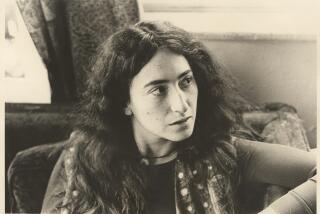The First Feminist : VINDICATION, <i> By Frances Sherwood (Farrar, Straus & Giroux: $22; 435 pp.)</i>
- Share via
There are a number of gifted novelists who write about the past in what is virtually a future tense. They do not use the assurance of history to tell us that this is how it was; instead, they project themselves and their readers, as if by time machine, back into a different place where everything is still uncertain and to be discovered. The voices and thoughts of their characters have unfamiliar timbres and associations. Rather than moving confidently backward out of the clarity of Now, we move uncertainly forwards out of the fogginess of Then.
Marguerite Yourcenar’s “Memoirs of Hadrian” worked that way. Russell Hoban’s “Riddley Walker” and Jim Crace’s “The Gift of Stones” took us into the constriction and immediacy of a Stone Age society which, being prehistoric, lacked the calm foreshortening of historical perspective. Adam Thorpe’s “Ulverton” gave us the voices of a dozen generations of an English village as if each generation were a separate national identity struggling to resolve itself.
Such fiction is light-years away from the traditional historical novel. We are only truly in the past when we feel lost in it. Of course we still perceive the characters, even if strangely; but we no longer feel, as we do somehow in the work of such conventional historical novelists as Gore Vidal, that the characters perceive us. They couldn’t; we have not been invented. This is oddly unsettling, but once unsettled we are up for a real journey.
Frances Sherwood’s “Vindication” plunges us into a brush fire of nerves, longings, weaknesses, passions and intelligence to make a portrait of Mary Wollstonecraft, an early English feminist. She loosens the blue stockings and comes up with a swirl of colors, only one of which is blue.
Wollstonecraft comes down to us as one of a circle of late 18th-Century radical thinkers and artists that included such figures as Thomas Paine, William Blake, William Godwin, Henry Fuseli, the dissenting minister Richard Price and others. She wrote the scandalously successful “Vindication of the Rights of Women,” which argued that women must cultivate their intellectual powers and independence, and exercise citizenship and the vote. She claimed that she could love man only as a fellow being and only as justified by the dictates of reason. Horace Walpole pronounced her “a hyena in skirts.”
So much for the tidy picture in the history books. True, there were some disheveled footnotes. Wollstonecraft was the lover of a flamboyant American writer and political adventurer named Gilbert Imlay, by whom she bore an illegitimate daughter. She made several attempts at suicide. She married Godwin, by whom she was pregnant, and died giving birth. The child was Mary, who eloped at 17 with Shelley, and wrote “Frankenstein.”
Footnotes are what you use when you don’t want to disarrange the text. Sherwood shatters the text. She does nothing so simple as write a novel about the “real”--e.g. colorful, passionate and reckless--Wollstonecraft inside the blue stockings. That would be another form of tidiness. “Vindication” makes the feminist as real as the woman; something that Camille Paglia also aims at, in a way, except that Paglia is a polemicist, not an artist. Sherwood, the artist, yokes two battling souls in a personage as bright and unstable as the blue light and red shift of a quasar.
Sherwood’s accomplishment is to give her Mary, with whom she takes various historical liberties, a voice and a mind that dart erratically as if released from a dark room into the light. Daughter of a vain and brutal father, terrified at having to make her penniless way in a time when a woman faced the choice between male protection and literal destitution, she has no plan. Her growing notion of what women should be comes in dizzy flashes, like stars from a blow to the head. Her growing up is a series of blows: her father beating her mother, her mother’s terrible death, service under a tyrannical old woman, with boils whose scabs flutter like “pot-lids.”
She and her two sisters start a school for girls based on serious book-learning and no physical punishment. When the school fails she goes as governess to an aristocratic family in Ireland. Her early writing comes to the notice of a radical London publisher, Joseph Johnson. He takes her in, gives her a job writing and brings her into his lively and eccentric circle. There is the publication of “Vindication,” a disastrous affair with the painter Henry Fuseli, a breakdown, a stay in France to report on the Revolution, her liaison there with Imlay who eventually abandons her, her return to London, marriage to Godwin and early death from childbirth fever, the decimator of women up into this century.
Sherwood’s Mary is mercurial, valiant and needy, and her peregrinations light up the variety of the times. There is her stay in the broken-down Irish mansion of Lady Kingsborough, a place of dogs, dirt and eccentricity. Her employer urges her to beat her two little girls, and the girls cheerfully demand it as well. Mary resists, but succumbs to the family’s gentle, funny, crippled 16-year-old son. In their mutual innocence, their passion is confined to what she later describes as “rubbing.”
There is a ripple of comedy throughout. Mary participates in Johnson’s boisterous Thursday dinners, at which Blake, Godwin and the other great men talk and eat expansively but she has to shout to get herself listened to, while fending off assorted inquiring feet under the tablecloth. Visiting Blake and his wife in their overgrown garden, she finds herself part of a not- entirely innocent Song of Innocence. Her middle-aged, roly-poly hosts strip naked and talk of angels; soon she is tipsy and naked herself, and being patted.
There are terrible scenes. Her agonizing death after the birth of little Mary is the more horrifying for the resignation with which she and the grief-swollen Godwin accept the medical helplessness of the time. Even among the enlightened, women had not only a different freedom but a different fate. A scene in Bedlam, where she is taken after a breakdown, is grisly but relatively pat. There is a prodigious storm at sea. The passengers huddle in the hold and Sherwood, whose phrases jar to Mary’s fierce and tremulous rhythms, writes: “The rain pelted, pelt, pel, pe, p the deck, stopped.”
Sometimes the author introduces a deliberately factual touch, with data about women’s employment and wages. Sometimes, particularly in the comedy, she uses Dickens-like contrasts of light and dark. This is particularly true of a few shining benevolences who light up Mary’s persistent but uncertain pilgrimage. Joseph Johnson, her rescuer and mentor, is one of the book’s most distinctive characters; eccentric, nurturing and gay in both senses. Mary’s movement from shock over the revelation to acceptance is told quite magically. So is her susceptible sexiness in which ardor and a protesting puzzlement are finely joined.
“Vindication’s” darting course through Mary’s poignant contradictions makes it uneven and disjointed at times. Occasionally we lose sight of her, as she loses sight of herself; we are becalmed as she is. But Sherwood has taken us to a past that is not so much another country as white-capped headwaters that do not yet know their river.
More to Read
Sign up for our Book Club newsletter
Get the latest news, events and more from the Los Angeles Times Book Club, and help us get L.A. reading and talking.
You may occasionally receive promotional content from the Los Angeles Times.










